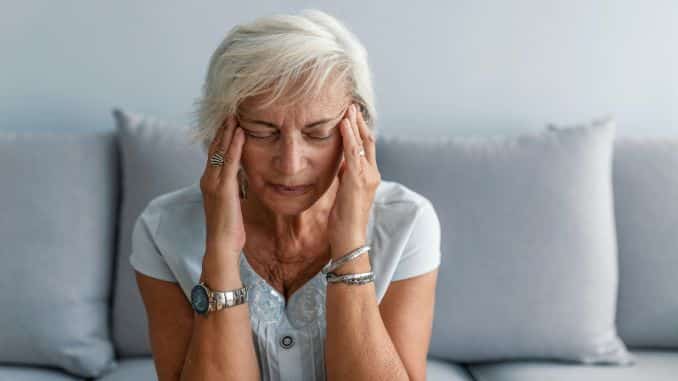
Headaches and migraines can be absolutely crippling, turning even the simplest tasks into major challenges. Imagine trying to work, socialize, or even enjoy a quiet evening with a constant, throbbing pain in your head.
The sensitivity to light and sound, nausea, and the need to lie down in a dark room can really disrupt daily life. It’s like having your brain hijacked, making it hard to focus or find any relief.
Often, these debilitating headaches are linked to trigger points—tight, sensitive areas in muscles that can cause pain in other parts of the body. Additionally, these points can be activated by stress, poor posture, or repetitive movements, leading to tension headaches or migraines.
Moreover, identifying and managing these trigger points through massage, stretching, and relaxation techniques can be key to reducing the frequency and intensity of headaches.
In this article, let’s delve deeper into this issue and explore the insights from a trigger point therapy practitioner. We will discuss how trigger points are identified, the methods used to alleviate pain, and the overall benefits of incorporating trigger point therapy into your routine.
Headaches can be broadly categorized into primary and secondary headaches. Primary headaches, such as tension-type headaches and migraines, are not caused by other medical conditions. In contrast, secondary headaches result from an underlying condition, such as a sinus infection or head injury
Types of Headaches

Migraines
Migraines are a type of primary headache characterized by intense, throbbing pain, usually on one side of the head. They are often accompanied by symptoms such as nausea, vomiting, and sensitivity to light and sound. Migraines can last from a few hours to several days and may be preceded by warning symptoms known as an aura. Moreover, certain factors, known as migraine trigger points, can set off these episodes. Migraine trigger points massage is a technique used to help alleviate the pain and manage these debilitating headaches. [¹]
Trigger Points Causing Headaches and Migraines
William Huhn, an NCBTMB Approved Provider, and skilled trigger point therapy practitioner, has helped many people find relief from headaches and migraines.
Hunn reported that about 95% of his clients feel much better after just two or three sessions. Some even stop having migraines or headaches altogether.
Huhn has found that by treating these trigger points, the pain can be greatly reduced or even go away completely.
“When medical professionals cannot find the source of your headaches or migraines, then it is about 95% sure that TrPs are causing the issue. Therefore, if the TrPs are removed, the pain should cease!” -William Hunn
This shows how helpful migraine trigger points massage can be for those dealing with constant headaches and migraines.
Understanding the Mechanism Behind Trigger Point Stimulation

Trigger point stimulation, also known as trigger point therapy, is a technique used to relieve pain and tension in specific areas of the muscles. Moreover, these areas, known as trigger points, are hyperirritable spots within a taut band of skeletal muscle that can produce pain locally and in referred areas. The mechanism behind trigger point stimulation involves several key processes:
A. Identification of Trigger Points
Trigger points are often identified by palpation, where a therapist or practitioner feels for knots or tight bands in the muscle. Moreover, these points are typically tender to the touch and can cause pain in other areas of the body, known as referred pain.
B. Mechanism of Trigger Point Stimulation
1. Mechanical Disruption
When pressure is applied to a trigger point, it can mechanically disrupt the contracted sarcomeres within the muscle fiber. Additionally, this pressure helps to release the tightness and restore normal muscle tone.
2. Increased Blood Flow
Applying pressure to a trigger point increases blood flow to the area. Enhanced circulation helps to deliver oxygen and nutrients to the affected muscle, while also removing metabolic waste products that contribute to pain and muscle stiffness.
3. Neuromuscular Effects
Trigger point stimulation can alter the nervous system’s response to pain. By applying pressure to the trigger point, the therapy can interrupt pain signals sent to the brain, reducing the sensation of pain. Additionally, it can modulate the autonomic nervous system, leading to a relaxation response and further pain relief.
4. Endorphin Release
The stimulation of trigger points can lead to the release of endorphins, which are natural pain-relieving chemicals produced by the body. Additionally, endorphins help to alleviate pain and promote a sense of well-being.
5. Muscle Lengthening
By applying sustained pressure, trigger point therapy can help to elongate the muscle fibers, reducing muscle tension and promoting a more relaxed muscle state. Additionally, this lengthening can also improve overall muscle flexibility and function.
6. Reduction of Inflammatory Chemicals:
Trigger points often contain a build-up of inflammatory chemicals [³] like substance P and cytokines. Pressure applied during trigger point stimulation can help to disperse these chemicals, reducing inflammation and associated pain.
Most Common Trigger Points that Lead to Headaches and Migraines
The most common trigger points (TrPs) [²] that produce migraines are found in specific muscles of the head and neck. Moreover, here are the key areas where these trigger points are typically located, explained in simpler terms:
1. Trapezius Muscle (Upper Back and Shoulders)
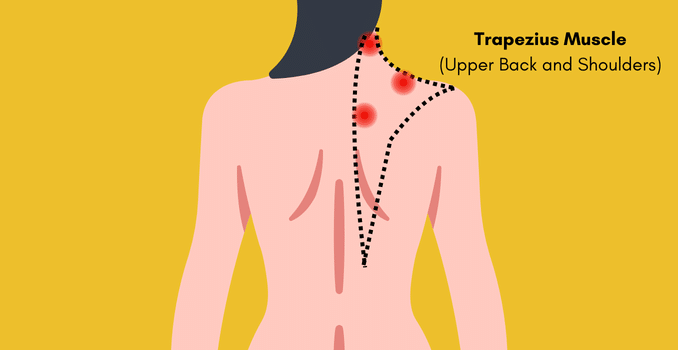
2. Sternocleidomastoids (Front of the Neck)
This large muscle extends from the neck down to the middle of the back and across the shoulders. Trigger points here can cause pain that radiates up to the head, leading to tension headaches and migraines.
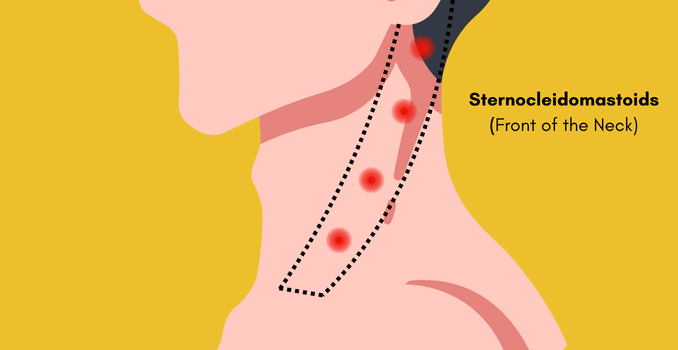
These muscles run along the front sides of the neck from the base of the skull to the collarbone. Trigger points here can cause a variety of symptoms, including pain in the forehead, behind the eyes, and in the temples, which are often mistaken for sinus headaches or migraines.
3. Suboccipitals (Base of the Skull)
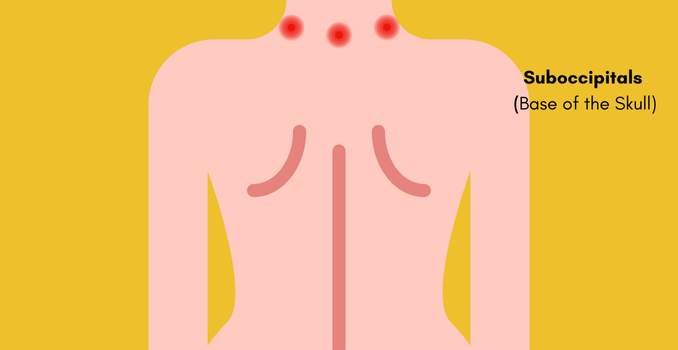
Located at the base of the skull, these small muscles are a common source of tension headaches. Additionally, trigger points here can cause pain that radiates up the back of the head and into the forehead, often feeling like a tight band around the head.
4. Temporalis Muscle (Side of the Head)
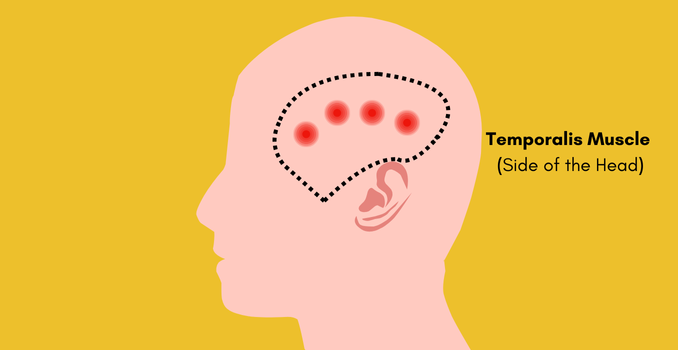
This muscle is located on the side of the head, above the ears. Trigger points in the temporalis can cause pain in the temples and contribute to the overall intensity of a migraine.
Other Headache and Migraine Interventions
1. Medications
For mild headaches, you might find relief with over-the-counter pain relievers like ibuprofen and acetaminophen. If you’re dealing with migraines, your doctor may prescribe triptans, which are specifically designed to alleviate migraine pain.
2. Lifestyle Changes
Incorporating regular exercise, maintaining a healthy diet, staying adequately hydrated, and getting sufficient sleep can help you prevent headaches and migraines. It’s also important to identify and avoid your specific triggers, such as certain foods, stress, and weather changes.
3. Alternative Therapies
You may find alternative therapies like acupuncture, biofeedback, and cognitive-behavioral therapy (CBT) effective in managing chronic headaches and migraines. Moreover, these therapies aim to reduce your stress and promote relaxation.
Migraine trigger points massage can be highly beneficial for those dealing with constant headaches and migraines, as it targets the root causes of migraine pain and provides much-needed relief.
4. Preventive Medications
If you experience frequent migraines, your doctor might recommend preventive medications such as beta-blockers, antidepressants, or antiepileptic drugs. Additionally, taking these medications daily can help reduce the frequency and severity of your migraines
Conclusion
In conclusion, stimulating headache trigger points offers a promising path to relief for those suffering from chronic headaches and migraines. Moreover, by identifying and managing these tight, sensitive areas in the muscles, significant pain reduction can be achieved.
The insights shared by William Huhn, an experienced trigger point therapy practitioner, underscore the effectiveness of this approach. Moreover, his success in helping clients alleviate their headaches after just a few sessions highlights the potential of trigger point therapy. The common trigger points—located in muscles such as the trapezius, sternocleidomastoids, suboccipital, and temporalis—are pivotal areas to focus on for relief.
Incorporating trigger point therapy into your routine, along with massage, stretching, and relaxation techniques, can not only reduce the frequency and intensity of headaches but also improve overall well-being. Additionally, for those whose headaches are unresponsive to traditional medical treatments, exploring migraine trigger points massage could be a game-changer in managing and potentially eliminating their pain.
Disclaimer: Consultation with a Healthcare Professional: It is essential to consult with a healthcare professional before starting any new treatment or therapy, especially if you have pre-existing medical conditions or are currently on medication.
Start your journey to relief now! Explore our 10 Gentle Yoga Poses for Migraine Relief designed to complement your pain management strategy.




